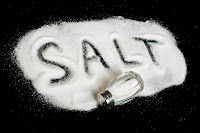To Shock or not to Shock? (Sous-Vide)
(OP- 2017) If I had a quarter for every time someone in the Sous-Vide groups asked this question, I'd be rich. If I had a quarter every time someone gave an opinion, I'd be filthy rich. You get my point. A friend of mine (Tal Nizani) asked me to explore & document what might be the differences between shocking and not shocking. Tal knows I love this stuff, and I am more than willing to run experiments.
This has been discussed ad nauseam, but no one has ever documented any results to my knowledge. My mantra has always been to SHOCK. When someone would pose this question to me directly or ask it in one of the food groups, my canned response was as follows.

If you don't shock first, you're adding heat to a protein that is already at its optimum temperature, which means it is going to higher than the SV-Process temperature.Once you remove the protein from the bath, let them rest at room temperature for up to 10-Minutes on a cool surface. Alternatively, using Ice-Cold Water from the tap for 5-Minutes. This allows the surface to cool somewhat. Doing so prevents the searing process from elevating the internal temperature beyond the original target temperature. Then, you can season, sear, and serve. If not using right away, use ice water @ 50/50 and refrigerate after cooled sufficiently.
 This post is both subjective and objective. It's subjective because parameters can alter the outcome but simultaneously objective too. Objective assessment is based on results derived from set parameters. I understand fully that if you were to change one or two of the variables, the results would be different. I welcome your effort and your analysis based on your own parameters and experimentation.
This post is both subjective and objective. It's subjective because parameters can alter the outcome but simultaneously objective too. Objective assessment is based on results derived from set parameters. I understand fully that if you were to change one or two of the variables, the results would be different. I welcome your effort and your analysis based on your own parameters and experimentation. 1-NY-Steaks that ranged in thickness from 28mm-33mm. 2-Steaks were Dry-Brined. 3-Mayo and pepper coating. 4-Steaks are seared in a Carbon-Steel-Pan. 5-Seared- Top/bottom @ 30-Secs and another 30-secs to cover the other sections. Think of a boat...Bow, Stern, Port, and Starboard. 6-Internal temp is taken after 5-Min Rest. EAT
Steak 1- After SV-Processed, Dried off, and Seared.
Steak 2- Rested for 10-Minutes before Sear. Rested on the counter for 8-Minutes (flipped multiple times) than prepped for Sear (exactly 10-minutes)
Steak 3- Rested for 6-Minutes. Cold-Tap Water shock for 4-Minutes and then prepped for Sear (exactly 6-minutes)
Steak 4- Shocked in Ice-Water and refrigerated overnight. Thin proteins can be rethermed in Hot-Tap-Water. Thicker proteins need to be SV-processed a few degrees below the original water temp. Protein will be rethermed (125℉) and seared. Tidbit- Very thin proteins don't need to be rethermed because searing will accomplish both tasks.
Note: The documented internal temperature after sear is regulated by the thickness of the protein. Thicker proteins will have a higher temp after sear based on the meats' thermal mass. I.e., A 2-Inch protein SV-Processed at 130f rested for 10-Minutes on a cold counter (rotated several times) will retain more heat towards the center than a 1-Inch protein.
 |
| CLICK ON PIC TO BLOW UP |
Steak One- Absolutely delicious!!! Yes, a slight gradient color near the perimeter, but I could not tell while eating. The fibrils tore easily, very moist, and had a great mouthfeel. See the Note above about resting internal temp.
 |
| CLICK ON PIC TO BLOW UP |
Steak Two- Just like steak two, freaking awesome!!!! Temp slightly less than steak two but could not tell. Less gradient at perimeter compared to steak one, but it was not detectable. Great mouthfeel too. Very moist!! See the Note above about resting internal temp.
 |
| CLICK ON PIC TO BLOW UP |
Steak Three- Just like the other steaks, which are freaking awesome!!!! Temp slightly less than Steak Two but could not tell. Less gradient at the perimeter compared to Steak One, but it was not detectable. Gradient color maybe just a little less than Steak Two. Very moist. Great mouthfeel too. See the Note above about resting internal temp.
 |
| CLICK ON PIC TO BLOW UP |
Steak Four- Again, remarkably similar to the other steaks. Allow me to translate...Freaking Awesome. Internal temp is higher than steak 2 & 4. It was slightly less gradient at perimeter than Steak One, Two & Three, but it was not detected in the chew test. See the Note above about resting internal temp.
Analysis- Let's start by saying all four steaks were excellent! If you were to close your eyes, you would most likely not be able to tell which steak you were eating.
Contrasting all four methods, I would say I am a big fan of Two, Three & Four. If aesthetics and gradient color are essential, then these are your winners. You only would use number Four if you weren't going to consume right away.
Two & Three because it has produced excellent results. I think "Two" because it was easier. In general kitchens, ambient temps don't change much (unless, of course, you live in a Hot-Climate with no AC). Steak Number Three's possible downside might be inconsistent Tap Water temp. Time in a water bath might be an issue too. The protein thickness would need to be considered before dropping in a cold water bath for "X" time. I used 4-Min for Steak #3, but it only really required 2-Min, which would have made for a higher internal temp after 5-Min rest. Fewer variables with the Counter resting method.
Again I want to stress that testing these 4-Steaks, would have different outcomes if using other parameters. What could alter the test? Your Skills, Searing Method (Charcoal Starter, Gas Grill, Electric Grill, Charcoal, Flat Top, Cast-Iron, Carbon-Steel, or Torch), etc. Was your surface as dry as these? Temp of the searing surface. Many many variables are most likely not listed here.
Note: A new method I started using was created by CREA, improving moisture retention and improving texture. CREA calls it a Step-Down-Cooling-Process. Remove protein from the cooking vessel and place it on the counter for 10-15-Minutes rotating a few times. If not, Searing right away, place in cold tap water for 10-15 minutes followed by ICE to shock for refrigeration. Note: I've tested CREAS theory... HERE UPDATE to the above statements.









Comments
Post a Comment